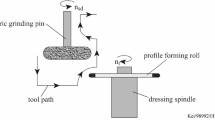Abstract
To machine high performance materials efficient and process safe, innovative tool concepts are required. Double face grinding with planetary kinematics is a process, which can be used to machine workpieces with high demands on flatness. Especially the kinematic of this process leads to an unequal wear shaping, which has a negative effect on the quality of the workpieces. Fulfilling the sophisticated task of ceramic machining, it is necessary to consider the chip formation and the associated wear of grinding tool based on existing approaches under consideration of the radius dependent speed gradient and significantly increased grinding wheel speeds as well. The research is the basis for the development of a tool, which allows predicting wear on the tool for double face grinding with planetary kinematics. Based on the knowledge about the wear, it is possible to design tools with requirements and customized for special processing task.







Similar content being viewed by others
References
Funck A (1994) Planschleifen mit Läppkinematik. In: Spur G (ed) Forschungsberichte für die Praxis. Karl-Hanser-Verlag, München
Uhlmann E, Ardelt T, Daus N (1998) Kinematische Analyse von Zweischeibenmaschinen. Werkstatttechnik 88(6):273–276
Rußner C (2006) Präzisionsplanschleifen von Al2O3-Keramik unter Produktionsbedingungen. Dissertation, Technische Universität Dresden
Klocke F, Linke B, Schluetter D (2010) Development of a reliable grinding procedure for ceramic medical instruments. Prod Eng Res dev 4(6):571–579
Geiger M, Arbak M, Engel U (2008) Material adapted tool design in cold forging exemplified by powder metallurgical tool steels and industrial ceramics. Prod Eng Res Dev 2(4):409–415
Uhlmann E, Ardelt T (1999) Influence of kinematics on the face grinding process on lapping machines. Ann CIRP 48(1):281–284
Uhlmann E, Ardelt T (2000) Kinematik und Prozeßverhalten beim Planschleifen mit Läppkinematik. In: Feinstbearbeitung technischer Oberflächen. In: Tagungsband zum 5. Int. IWF-Kolloquium, pp 93–105
Uhlmann E (1993) Tiefschleifen hochfester keramischer Werkstoffe. In: Spur G (ed) Forschungsberichte für die Praxis. Karl-Hanser-Verlag, München
Ardelt T (2000) Einfluss der Relativbewegung auf den Prozess und das Arbeitsergebnis beim Planschleifen mit Planetenkinematik. In: Uhlmann E (ed) Berichte aus dem Produktionstechnischen Zentrum Berlin. Fraunhofer-Verlag, Stuttgart
Egger R (2001) Planschleifen von Keramik mit zykloider Wirkbewegung. Dissertation, Universität Hannover
Simpfendörfer D (1988) Entwicklung und Verifizierung eines Prozeßmodells beim Planläppen. In: Spur G (ed) Forschungsberichte für die Praxis. Karl-Hanser-Verlag, München
Uhlmann E, Sammler C, Hoghé T, Borsoi Klein T (2009) Einsatz innovativer Schleifverfahren macht Hochleistungsbearbeitung wirtschaftlicher. Maschinenmarkt 30:22–26
Oliveira JFG, Silva EJ, Guo C, Hashimoto F (2009) Industrial challenges in grinding. Ann CIRP 58:663–680
Kassen G (1969) Beschreibung der elementaren Kinematik des Schleifvorgangs. Dissertation, Rheinisch-Westfälische Technische Hochschule Aachen
Bifano TG, Dow T, Scattergood RO (1991) Ductile-regime grinding: a new technology for machining brittle materials. J Eng Ind 113:184–189
Author information
Authors and Affiliations
Corresponding author
Rights and permissions
About this article
Cite this article
Uhlmann, E., Hoghé, T. Wear reduction at double face grinding with planetary kinematics. Prod. Eng. Res. Devel. 6, 237–242 (2012). https://doi.org/10.1007/s11740-012-0376-8
Received:
Accepted:
Published:
Issue Date:
DOI: https://doi.org/10.1007/s11740-012-0376-8




